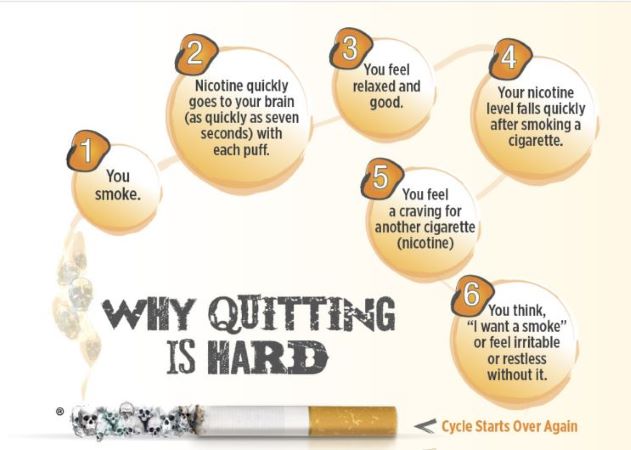
Smoking is highly addictive primarily due to the presence of Nicotine, a chemical found in the leaves of a tobacco plant.
When a person takes the first puff, within a few seconds nicotine makes your brain release a feel good chemical called Dopamine that:
• makes you feel happy
• helps you to concentrate
• gives you more energy
How It Works
Within a few seconds of inhalation of the smoke, nicotine enters the lungs and absorbs quickly into the bloodstream. Once absorbed, it reaches the brain quickly and is also distributed to various organs and tissues, including the heart, liver, and kidneys. When nicotine reaches the brain, it activates structures normally present in the brain called receptors. When these receptors are activated, they release a brain chemical called dopamine, which makes a person feel good. Dopamine release from nicotine is temporary and the pleasurable effects are short-lived. Once its level declines in the body, a person craves for another cigarette to get more dopamine to feel good.
As the nicotine levels in your body fade, people need to use more and more tobacco to get that same good feeling.
Once they are dependent on nicotine, without it they will have withdrawal symptoms. They may find it difficult to concentrate or feel nervous, restless, irritable, or anxious.
These two things — nicotine dependence and nicotine withdrawal — make them want to smoke more. This is how they become dependent on nicotine and addicted to smoking.
It only takes one cigarette to become addicted
In year 2018, a 16-year study shows it only takes one cigarette to become addicted. Data from 215,000 individuals in Australia, New Zealand, the U.S. and the UK revealed 60.3 percent of people had tried smoking and about 68.9 percent of those people continued smoking daily. You might want to try just one cigarette thinking you won't become addicted. But as shown from this comprehensive study, it's more than likely just one puff can turn into a daily habit.
